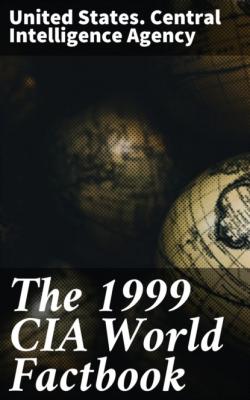The 1999 CIA World Factbook. United States. Central Intelligence Agency
Чтение книги онлайн.
Читать онлайн книгу The 1999 CIA World Factbook - United States. Central Intelligence Agency страница 13
 Remembrance Day for Martyrs and Disabled, 4 May; Independence Day,
Remembrance Day for Martyrs and Disabled, 4 May; Independence Day,19 August
Constitution: none
Legal system: a new legal system has not been adopted but all factions tacitly agree they will follow Shari'a (Islamic law)
Suffrage: undetermined; previously males 15–50 years of age
Executive branch: on 27 September 1996, the ruling members of the
Afghan Government were displaced by members of the Islamic Taliban
movement; the Islamic State of Afghanistan has no functioning
government at this time, and the country remains divided among
fighting factions
note: the Taliban have declared themselves the legitimate government
of Afghanistan; the UN has deferred a decision on credentials and
the Organization of the Islamic Conference has left the Afghan seat
vacant until the question of legitimacy can be resolved through
negotiations among the warring factions; the country is essentially
divided along ethnic lines; the Taliban controls the capital of
Kabul and approximately two-thirds of the country including the
predominately ethnic Pashtun areas in southern Afghanistan; opposing
factions have their stronghold in the ethnically diverse north
Legislative branch: non-functioning as of June 1993
Judicial branch: non-functioning as of March 1995, although there
are local Shari'a (Islamic law) courts throughout the country
Political parties and leaders: Taliban (Religious Students
Afghanistan comprised of Jumbesh-i-Melli Islami (National Islamic
other smaller parties are Hizbi Islami-Gulbuddin (Islamic Party)
SAYYAF]; Harakat-Inqilab-i-Islami (Islamic Revolutionary Movement)
GAILANI]; Hizbi Wahdat-Akbari faction (Islamic Unity Party)
Political pressure groups and leaders: tribal elders represent
traditional Pashtun leadership; Afghan refugees in Pakistan,
Australia, US, and elsewhere have organized politically; Peshawar,
Pakistan-based groups such as the Coordination Council for National
International organization participation: AsDB, CP, ECO, ESCAP,
FAO, G-77, IAEA, IBRD, ICAO, ICRM, IDA, IDB, IFAD, IFC, IFRCS, ILO,
IMF, Intelsat, IOC, IOM (observer), ITU, NAM, OIC, OPCW, UN, UNCTAD,
UNESCO, UNIDO, UPU, WFTU, WHO, WMO, WToO
Diplomatic representation in the US: note: embassy operations suspended 21 August 1997 chief of mission: Ambassador (vacant) chancery: 2341 Wyoming Avenue NW, Washington, DC 20008 consulate(s) general: New York
Diplomatic representation from the US: the US embassy in Kabul
has been closed since January 1989 due to security concerns
Flag description: three equal horizontal bands of green (top),
white, and black with a gold emblem centered on the three bands; the
emblem features a temple-like structure with Islamic inscriptions
above and below, encircled by a wreath on the left and right and by
a bolder Islamic inscription above, all of which are encircled by
two crossed scimitars
note: the Taliban uses a plain white flag
Economy
Economy—overview: Afghanistan is an extremely poor, landlocked country, highly dependent on farming and livestock raising (sheep and goats). Economic considerations have played second fiddle to political and military upheavals during two decades of war, including the nearly 10-year Soviet military occupation (which ended 15 February 1989). During that conflict one-third of the population fled the country, with Pakistan and Iran sheltering a combined peak of more than 6 million refugees. Now, only 750,000 registered Afghan refugees remain in Pakistan and about 1.2 million in Iran. Another 1 million have probably moved into and around urban areas within Afghanistan. Gross domestic product has fallen substantially over the past 20 years because of the loss of labor and capital and the disruption of trade and transport. Much of the population continues to suffer from insufficient food, clothing, housing, and medical care. Inflation remains a serious problem throughout the country, with one estimate putting the rate at 240% in Kabul in 1996. International aid can deal with only a fraction of the humanitarian problem, let alone promote economic development. Government efforts to encourage foreign investment have not worked. The economic situation did not improve in 1998. Numerical data are likely to be either unavailable or unreliable.
GDP: purchasing power parity—$20 billion (1998 est.)
GDP—real growth rate: NA%
GDP—per capita: purchasing power parity?$800 (1998 est.)
GDP—composition by sector: agriculture: 53% industry: 28.5% services: 18.5% (1990)
Population below poverty line: NA%
Household income or consumption by percentage share:
lowest 10%: NA%
highest 10%: NA%
Inflation rate (consumer prices): 240% (1996 est.)
Labor force: 7.1 million
Labor force—by occupation: agriculture and animal husbandry 67.8%, industry 10.2%, construction 6.3%, commerce 5%, services and other 10.7% (1980 est.)
Unemployment rate: 8% (1995 est.)
Budget:
revenues: $NA
expenditures: $NA, including capital expenditures of $NA
Industries: small-scale production of textiles, soap, furniture,
shoes, fertilizer, and cement; handwoven carpets; natural gas, oil,
coal, copper
Electricity—production: 540 million kWh (1996)
Electricity—production by source: fossil fuel: 35.19% hydro: 64.81% nuclear: 0% other: 0% (1996)
Electricity—consumption: 660 million kWh (1996)
Electricity—exports: